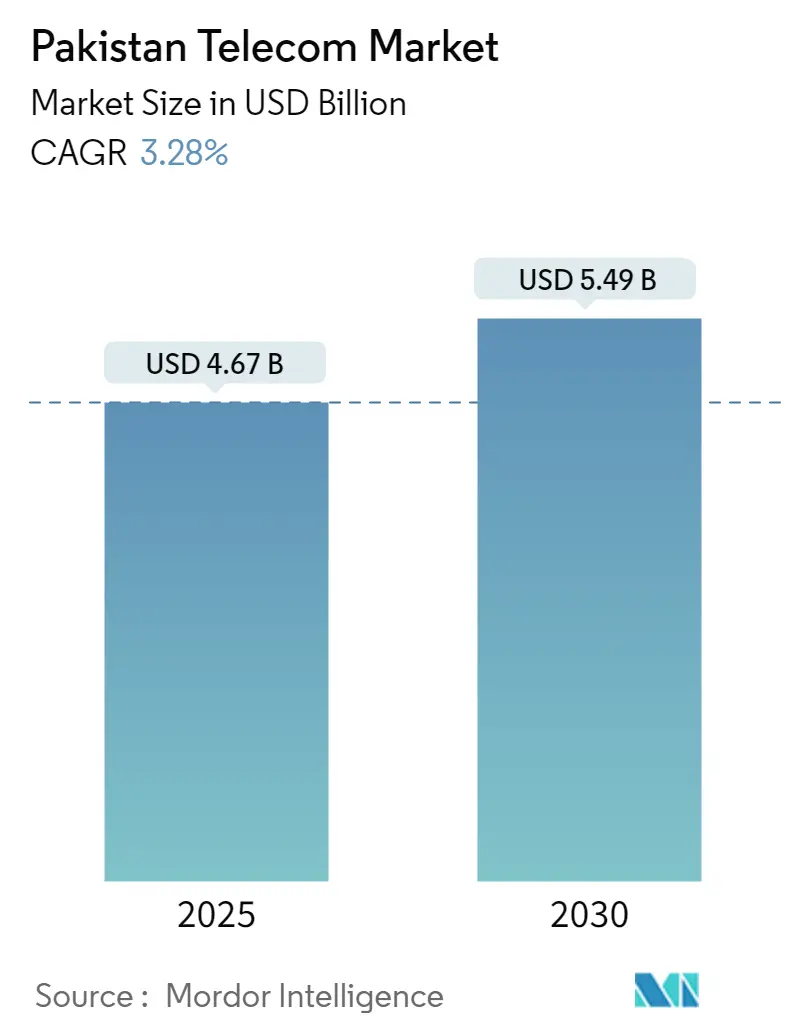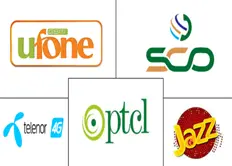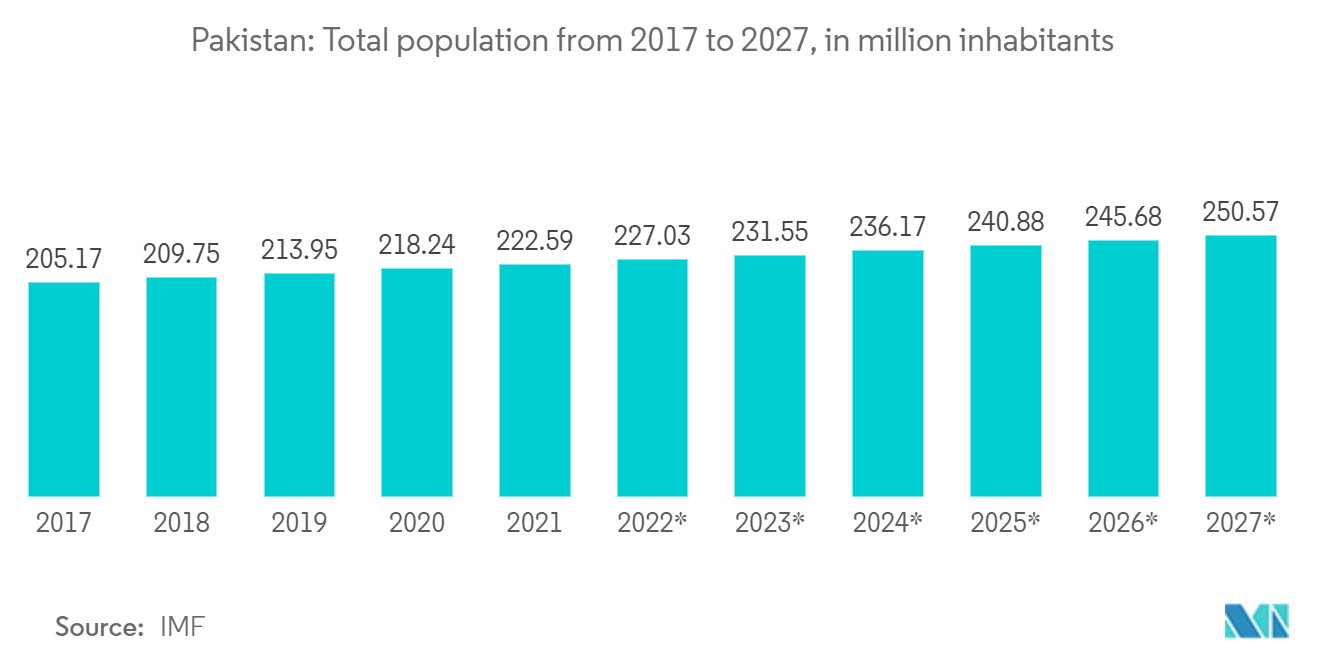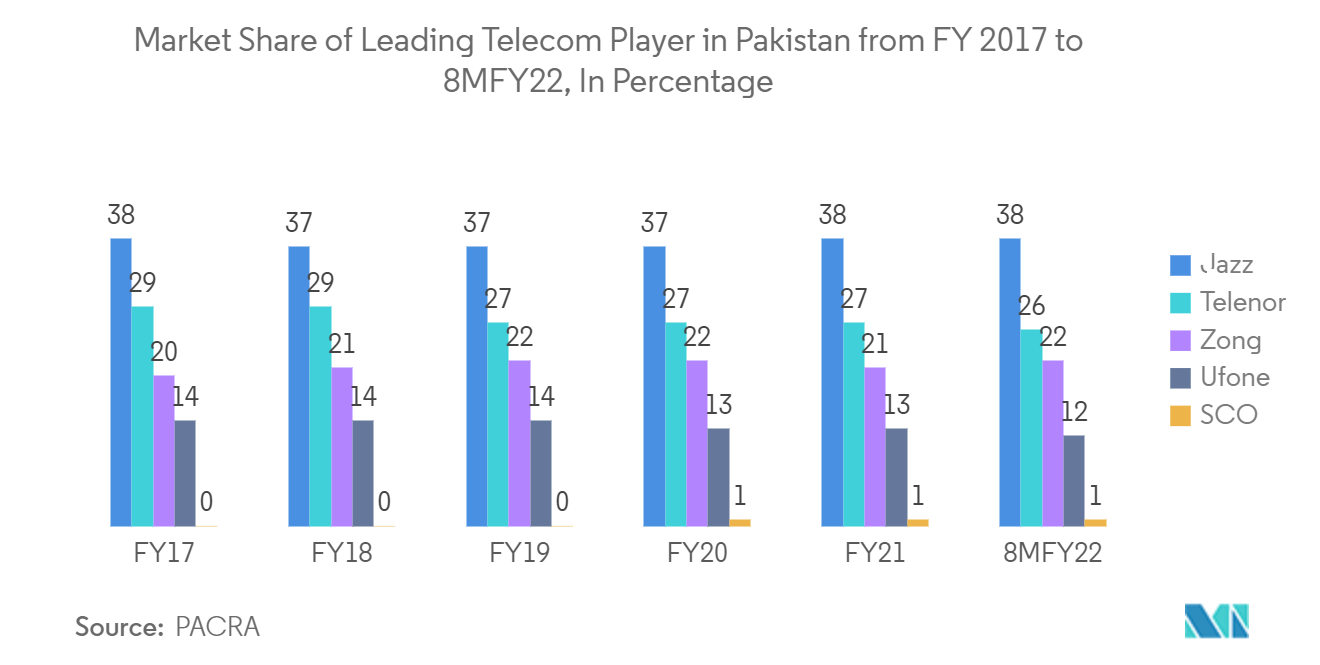
| Study Period | 2019 - 2030 |
| Base Year For Estimation | 2024 |
| Forecast Data Period | 2025 - 2030 |
| Market Size (2025) | USD 4.67 Billion |
| Market Size (2030) | USD 5.49 Billion |
| CAGR (2025 - 2030) | 3.28 % |
| Market Concentration | Low |
Major Players
*Disclaimer: Major Players sorted in no particular order |
Pakistan Telecom Market Analysis
The Pakistan Telecom Market size is estimated at USD 4.67 billion in 2025, and is expected to reach USD 5.49 billion by 2030, at a CAGR of 3.28% during the forecast period (2025-2030).
The growth can be attributable to the development of Pakistan's 3G, 4G, and 5G services. Tele density in Pakistan has increased exponentially in recent years and is also expected to rise in the upcoming years. The FDI trends in the telecom sector in Pakistan have been promising and beneficial. Among the dominant telecom players in the country, Jazz has the highest subscriber base and a very strong position.
- The telecom industry had a large increase in demand during the last financial year from corporate organizations and individuals alike to satisfy the social, educational, commercial, health-related, and economic requirements across the nation. The service providers in Pakistan are merging and recreating entertainment offers through new service bundles and entertainment products and adopting these brand-new tactics that can boost organizational flexibility and uphold client demand.
- The Pakistani government is working to improve the procedures for bringing 5G to the nation. In collaboration with key stakeholders, the Ministry of Information Technology, PTA, and FAB are successfully working together to deploy 5G in Pakistan. Although the debut was delayed by over three months because of political upheaval in Pakistan, the government intends to introduce 5G technology in the country by March next year. The rollout is expected to begin with Islamabad, Karachi, and Lahore, the three largest cities in the nation. Also, Pakistan is poised to enter the age of artificial intelligence thanks to a populace and a government that is becoming more responsive to geoeconomic conditions.
- Pakistan's telecom industry is still less developed than that of most other Asian nations. This is partially a result of the fixed-line network's poor condition due to years of underinvestment and neglect by the incumbent state-owned telecom Pakistan Telecommunication Company (PTC), with teledensity presently at practically 1%. However, due to this lack of concentration, mobile can overtake other platforms as the main voice and data platforms. The country's mobile voice and mobile broadband sectors have recently experienced double-digit subscriber growth rates. Pakistan's mobile industry is fiercely competitive, unlike the fixed network sector.
- Future growth (in market size and revenue) is likely to come from expanding value-added services in addition to the 4G LTE and (starting next year) 5G mobile networks. With several projects approved in the last and current year, the Universal Service Fund (USF) continues to drive investment toward developing mobile broadband (and, to a lesser degree, fiber-based networks) in underserved and even unserved portions of the nation. Operators like Telenor and Ufone are connecting the unconnected, thanks to coverage that extends deep into many of Pakistan's most isolated regions and in some of the nation's most challenging terrains, from the country's mountainous north to its expansive desert south.
- Pakistan Telecom service providers were under huge pressure owing to the impacts of COVID-19 to provide high-quality, dependable, and quick connection data services. The country's telecom industry largely provided vital infrastructure and resources. It depended on high-speed data service to ensure that the health sector had access to the worldwide information networks and resources required. Broadband access became indispensable for companies and educational institutions to continue offering vital services. Also, COVID-19 has significantly led to a remarkable increase in the usage of digital solutions in the country.
Pakistan Telecom Market Trends
Accelerating Digital Transformation
- The pandemic's emergence has been crucial in fostering the growth of digitalization in the telecom sector. Additionally, Pakistan has achieved considerable progress in telecommunications, which has become a crucial driver of the nation's economy. Most businesses have implemented several technologies into their business operations or are in the process of doing so. Pakistani telecoms would provide a superior customer experience as they prepare to modernize and simplify their business processes with the aid of agile digital solutions. Overall, the nation's telecoms environment is expected to shift significantly. One of them, digital transformation, would be crucial in determining the future of the telecoms sector and paving the way for future growth.
- High-speed internet access, digital identity frameworks, and multiple-sided platforms provide the basic components for successful digital citizenship, luxurious digital lives, and a digital economy. Mobile is a part of the Fourth Industrial Revolution's goal of bridging connection gaps, boosting financial inclusion, and sustainably transforming verticals. It is made possible by mobile, which is at the heart of Pakistan's national development strategy and its march along the digital society route. Due to Pakistan's relatively lower fixed internet penetration, the mobile connection is mostly used to access digital services.
- Furthermore, at the event held at PTCL Headquarters, PTCL Group, one of the leading telecom organizations in the nation, tested the 5G technology. The 5G study was run in a constrained setting on an unaffiliated basis. By linking people with reliable, purpose-built technology, 5G would aid in Pakistan's digitalization, creating benefits for both individuals and businesses. Future innovations in industries, including manufacturing, public safety, transportation, and remote education, would be made possible by this technology. Mobile carriers and fixed-wireless providers could deliver richer services and improve client experiences thanks to the technology.
- Notably, in December 2021, a meeting between Ericsson Pakistan and the Ministry of Information Technology and Telecommunication (MoITT) was conducted to discuss digitization, skill development, and engineer training in keeping with the goals of Digital Pakistan. In keeping with the goals of digitalization, Ericsson is dedicated to driving growth and diversification to attract capital and the finest technologies to Pakistan. The company is optimistic about the future of the nation's digital progress following the productive discussion with the Ministry. Moreover, the Pakistan Telecommunication Authority (PTA) and MoITT played crucial roles in the expansion of the country's access to high-quality connectivity and digital services on a national and provincial level. For the people of Pakistan, this has encouraged digital inclusiveness, e-commerce, and a general spirit of entrepreneurship.
- According to IMF, the total population of Pakistan would grow by a total of 23.5 million people (+10.35%) between 2022 and 2027. This prediction states that by 2027, the population will have grown steadily, reaching 250.57 million people. Notably, internet usage across the population has been steadily growing throughout the past few years. At the beginning of 2022, 36.5% of Pakistan's population used the internet. According to Kepios research, between 2021 and 2022, the number of internet users in Pakistan rose by 22 million (+35.9%).

Rising Wireless Density
- Pakistan's wireless or mobile phone sector expanded during the start of the twenty-first century. Pakistan has seen a rise in the number and density of mobile phone users in the last decade. According to PTA data, the semi-urban regions of Punjab province, including Bahawalpur, Sadiqabad, Hyderabad, Abbottabad, and Mardan, have witnessed the highest rates of mobile penetration. The COVID-19-related lockdown limitations have increased the reliance on internet access by making the idea of "work from home" more widespread than ever, thereby increasing the demand for smartphones in the country.
- The YoY increase rate of tele density is generally greater than the average population growth trend. In Pakistan, persons aged 15 to 64 make up around 60% to 65% of the overall population and are considered mobile sim customers. This age group's growth pattern is consistent with the pace of population growth in general. According to PACRA, the country's tele density as of February this year was 88%. Cellular mobile phones accounted for over 99% of all tele density, whereas Wireless Local Loop (WLL) and Fixed Local Loop barely make up 1%. (FLL)
- According to PTA, by the end of June this year, Pakistan had 1.32 million more cellular subscribers than it did at the end of May this year, bringing the total to 194.58 million. The tele density for cellular mobile increased from 87.8% in May to 88.34% by the end of June of this year. By the end of May this year, the total tele-density increased from 88.94% to 89.53% by June. By the end of May 2022, the Monthly Next Generation Mobile Service (NGMS) penetration was 51.73%, and by June this year, it was 52.55%.
- Furthermore, the government intends to shift the trend away from importing things and toward exporting items to assist the economy by encouraging local investors to produce their own high-tech products that can also be sold. In July last year, Pakistani suppliers and retailers of mobile phones imported phones worth USD 119.2 million, while this year, just USD 38.8 million worth of phones were imported. On an annual basis, the imports decreased by 67% compared to last year. To address the demand for mobile phones across the country, Pakistan has excelled in producing local handsets and has progressively started to export mobile phones.
- Pakistan Mobile Telecommunication Limited (Jazz), Telenor Pakistan (Telenor), China Mobile Pakistan Limited (Zong), and Pakistan Telecom Communication Limited (Ufone) are the four major participants in the telecommunications industry. With the most subscribers, Jazz is in the best position. According to a PACRA report, during the first eight months of this year, Jazz had a 38% market share in mobile subscribers, followed by Telenor, which holds a 26% share. SCO, a company that operates solely in Gilgit Baltistan, has the smallest market share. The level of competition is anticipated to rise further as regional businesses employ aggressive tactics to grow their subscriber bases.

Pakistan Telecom Industry Overview
The Pakistan telecom market is moderately fragmented. Some major players in the market studied include Pakistan Telecommunication Company Ltd (PTCL), Pakistan Mobile Communications Limited (Jazz), Telenor Pakistan Limited, Pak Telecommunication Mobile Limited (Ufone), and Special Communications Organization. The market also hosts other Internet service providers (ISPs), MVNOs, and fixed-line service providers. Some Pakistani telecommunication companies are competitive internationally and hold firm ground in the global telecom space.
In August 2022, Pakistan Telecommunication Company Limited announced that it had formed a partnership with Huawei to launch Smart Solutions powered by the latter. The program would provide businesses with one-window, intelligent telecommunication services that are 100% safe and dependable.
In May 2022, the market-leading Pakistani service provider Jazz came into a contract with Nayatel, the fiber infrastructure and services provider. This agreement would immediately enable Jazz to connect all its mobile towers directly to fiber in Lahore. By December 2022, this fiber-to-the-site (FTTS) project is anticipated to be finished.
Pakistan Telecom Market Leaders
-
Pakistan Telecommunication Company Ltd (PTCL)
-
Pakistan Mobile Communications Limited (Jazz)
-
Telenor Pakistan Limited
-
Pak Telecommunication Mobile Limited (Ufone)
-
Special Communications Organization
- *Disclaimer: Major Players sorted in no particular order

Pakistan Telecom Market News
- In October 2022, Pakistan Telecommunication Company Ltd (PTCL) unveiled that it had penned to collaborate with Evision to launch a video streaming platform. According to PTCL, the new digital video over-the-top (OTT) platform would provide news and entertainment by hosting Hollywood and Pakistani entertainment material in addition to various national and international news and sports channels.
- In June 2022, Pakistan's top voice and data network, Ufone, introduced the most extensive and economical hybrid package in the market, the "Sab Se Bari Offer," to facilitate the finest user experience for its clients. This hybrid package gives consumers more convenience, control, and enabling options so they may use the company's top-notch voice and data services for longer while engaging in business-related activities, education, or pleasure.
Pakistan Telecom Industry Segmentation
Telecom or Telecommunication is the long-range transmission of information by electromagnetic means.
Pakistan's Telecom Market includes in-depth trend analysis based on connectivity like Fixed Networks, Mobile Networks, and Telecom Towers. The telecom services are divided into Voice Services (Wired and Wireless), Data and Messaging Services, and OTT and PayTV Services. The adoption of telecom services is likely driven by several factors, including an increasing demand for 5G.
The market sizes and forecasts are provided in terms of value (USD million) for all the above segments.
| Segmentation by Services (Coverage to include Average Revenue Per User for the overall Services segment, Market size and Estimates for each segment for the period of 2020-2027 and in-depth Trend Analysis) | Voice Services | Wired |
| Wireless | ||
| Data and Messaging Services (Coverage to include Internet & Handset Data packages, Package Discounts) | ||
| OTT and PayTV Services |
Pakistan Telecom Market Research FAQs
How big is the Pakistan Telecom Market?
The Pakistan Telecom Market size is expected to reach USD 4.67 billion in 2025 and grow at a CAGR of 3.28% to reach USD 5.49 billion by 2030.
What is the current Pakistan Telecom Market size?
In 2025, the Pakistan Telecom Market size is expected to reach USD 4.67 billion.
Who are the key players in Pakistan Telecom Market?
Pakistan Telecommunication Company Ltd (PTCL), Pakistan Mobile Communications Limited (Jazz), Telenor Pakistan Limited, Pak Telecommunication Mobile Limited (Ufone) and Special Communications Organization are the major companies operating in the Pakistan Telecom Market.
What years does this Pakistan Telecom Market cover, and what was the market size in 2024?
In 2024, the Pakistan Telecom Market size was estimated at USD 4.52 billion. The report covers the Pakistan Telecom Market historical market size for years: 2019, 2020, 2021, 2022, 2023 and 2024. The report also forecasts the Pakistan Telecom Market size for years: 2025, 2026, 2027, 2028, 2029 and 2030.
Our Best Selling Reports
Pakistan Telecom Industry Report
Statistics for the 2025 Pakistan Telecom market share, size and revenue growth rate, created by Mordor Intelligence™ Industry Reports. Pakistan Telecom analysis includes a market forecast outlook for 2025 to 2030 and historical overview. Get a sample of this industry analysis as a free report PDF download.




